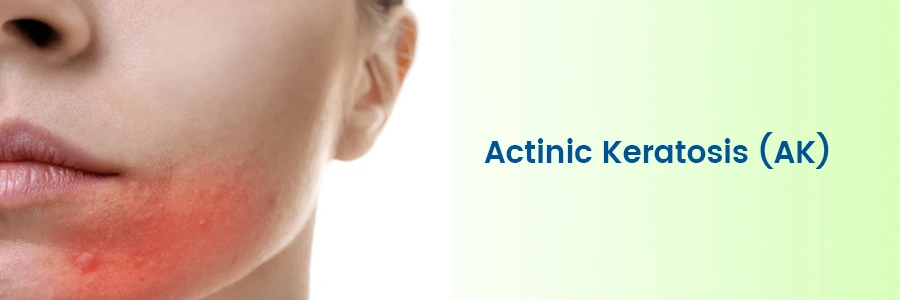Actinic Keratosis (AK)

Long-term exposure to the sun can result in a rough, scaly patch on the skin, known as actinic keratosis (AK)!
Actinic Keratosis is usually found on the lips, face, ears, forearms, scalp, neck, and back of hands. AK develops slowly and typically shows up in adults over the age of 40. One can lower the risk of developing this skin condition by limiting daily exposure to the sun and protecting the skin from ultraviolet (UV) rays. If left untreated, actinic keratoses have a 5% to 10% chance of developing into squamous cell carcinoma, a type of skin cancer.
The most effective way for people to avoid AK is to protect themselves against sun damage. They must visit a doctor for diagnosis and treatment if they notice new red or rough bumps on their skin. Let's understand the condition, its causes, symptoms, prevention, and treatment.
What is Actinic Keratosis (AK)?
Actinic Keratoses is a premalignant lesion of sun damaged skin. If left untreated,it can lead to cancer.
What are the symptoms of actinic keratosis?
The first sign of actinic keratosis is typically rough, raised bumps on the skin that vary in color but often have a brown or yellow crust on top. These lumps might be grey, pink, red, or the skin's color. The following symptoms may also be present:
- Dry, scaly lips
- Loss of color in the lips
- Bleeding
- Pain or tenderness
- Ulceration
- Induration
- Burning, stinging, or itching
What are the causes of actinic keratosis?
Actinic keratosis is most commonly caused by repeated or intense exposure to ultraviolet (UV) light from the sun or from indoor tanning devices like tanning beds. UV rays can harm the outer layer of skin cells known as keratinocytes.
How is actinic keratosis treated?
The treatment option for a patient with actinic keratosis is determined by the number of AKs and their appearance. During an appointment, the doctor may recommend that the skin patches be removed. To treat actinic keratosis, the doctor may employ the following methods:
1. Chemical peels
These look like medical-grade face masks. During an appointment, the doctor will apply the peel. The ingredients in the treatment safely remove undesirable areas in the top layer of skin. The treated area will be red and sore for the first few days. The patient may notice a fresh, healthy layer of skin as the skin heals.
2. Cryotherapy
When an individual has one or two AKs, the doctor may recommend cryotherapy. The doctor may use a cold chemical such as liquid nitrogen to freeze skin growth during this operation. These growths will blister and peel off within a few days after the treatment.
3. Excision
The doctor may first numb the skin around the AK during this surgery. The doctor cuts or scrapes the AKs away and stitches the wound. The wound usually takes two to three weeks to heal.
4. Photodynamic therapy
When patients have several AKs or AKs that return after treatment, the doctor may recommend photodynamic therapy. Creams and specific light treatments eliminate precancerous skin cells during this procedure. Patients must avoid the sun for a few days while the treated skin recovers.
5.Surgery and biopsy
The doctor may surgically remove the lesion to determine whether the AK is cancerous.
Can actinic keratosis return after the treatment?
Yes! Actinic keratosis might reoccur if people do not protect them from further UV damage. They must restrict their exposure to UV light both during and after the treatment.
How can people prevent actinic keratosis?
The best method for avoiding actinic keratosis is to avoid prolonged UV exposure. People can also keep their skin healthy by doing the following:
- Applying sunscreen every day, even in the winter or when it's cloudy outside, and reapplying it every two hours at the very least
- Avoiding the sun from 10 am to 2 pm, when UV light is at its strongest.
- Avoiding sunlamps, tanning salons, and tanning beds.
- Wearing long pants, long sleeves, and caps protects against the sun.
- Regularly check the skin for lesions and inform the doctor of any findings.
Conclusion
Skin conditions like actinic keratosis require immediate medical attention. With surgical or topical treatment, the majority of AKs disappear. By protecting the skin from ultraviolet light and the sun, people can reduce their risk of developing actinic keratosis. To lower the risk of developing skin cancer, people should seek treatment for actinic keratosis as soon as they feel they may be experiencing symptoms.
Skin Treatment at Medicover Hospitals
At Medicover Hospitals, we personalize the Actinic Keratosis (AK) treatment to provide compassionate care, an accurate diagnosis, and an effective treatment plan that works for you. We have the best team of dermatologists who are very experienced in diagnosing and treating actinic keratosis in children and adults, including the rarest and most complex types. If you need help with your skincare, our skincare specialists at Medicover Hospitals will work with you to arrange your care.

